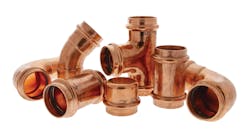Latest from Hydronics
Sponsored
Alexandria, Va. — An Antebellum estate located here received a hydronic makeover thanks to Foley Mechanical, a mechanical contracting firm located here that specializes in hydronic and HVAC systems.
The federal-style estate, circa 1860s, now has a ProPressed copper hydronic system that delivers comfort to the homeowners through cast iron radiators, low-temp radiant floor heat and hydro-air. The recent renovation included a three-story addition off the back of the house, including a basement and first and second story, which added about 1,900-sq.ft. Also, an additional 600-sq.ft. was added to the side of the house, giving the estate 12,000-sq.ft. of total floor space.
“There have been numerous additions and renovations over time, and the last one in 1990 involved a new mechanical package, but left the drafty estate intact,” explained Dan Foley, president of Foley Mechanical. “When they called upon my team this time around, I advised them on the best mechanical system available, and just as importantly, I recommended they tighten up the home.”
Foley designed and installed new mechanical systems for the entire home and new addition. The first step was to gut most of the ductwork and pipes along with the previous system.
“The ductwork for the existing first floor had to stay intact, but for the second floor, including the master suite, the entire mechanical system was redone,” said Foley.
Part of the renovation was removing a 1.1 million Btuh cast iron sectional commercial boiler. The boiler was kept hot 365 days a year for domestic hot water demand — with a tankless coil and two 200-gal. commercial storage tanks, it provided heated water at a substantial cost and wasted fuel.
“When we first visited to assess the mechanicals, the boiler room in July was well above 100°F,” said Foley. “You know it's a huge waste of energy when it's 100°F outside and you hear that burner. You wouldn't keep a pot of water boiling 24 hours a day because you want to have an occasional cup of tea.”
With no natural gas supply (the homeowners were not interested in using LP gas), the new system was designed for oil. Foley chose two Viessmann Vitorond 200 VR2-63s with Riello burners that have a heating capacity of 245,000 Btuh. The modulating cold-start boilers fire only when there's demand, using a triple-pass heat exchanger surface to achieve a combustion efficiency of 86.9% AFUE. Domestic hot water is channeled into a 120-gal. dual coil commercial indirect. No alternative venting was required since the homeowners had just lined the chimney with stainless steel.
Foley's team installed radiant heat to a front-entry vestibule, first-floor gallery, basement laundry room and side entry. An open area for entertaining, extending across the entire back of the house, is served by staple-up radiant with heat transfer plates and, because of the heat load, a second-stage air handler, all heated by the Vitorond boilers.
Hydro-air is used for the remainder of heating. Seven air handlers throughout the house are used for air conditioning. Heat pumps are utilized for efficiency when the temperature is above 35°F, and when temperatures drop below 35°F the system switches over to the boilers.
Tekmar staging, reset and mixing controls operate the system, Belimo floating action motorized mixing valves control the radiant water temperature, and Caleffi zone valves control the flow provided by three-speed Grundfos pumps with built-in flow-check valves. Isolation flanges provide for repair and maintenance without having to drain the entire system.
“We like the three-speed pumps for their versatility,” said Foley. “They allow us to match the flow of the pump to the head-loss of the zone it's feeding.”
A total of nine high-temp hydro-air zones and four radiant zones make the fine tuning of this hydronic system possible. One of the air handlers uses motorized dampers to split its supply into three zones to direct air where necessary.
“Even with the addition of 2,500-sq.ft., the new system is burning half the fuel,” Foley commented. “We cut the Btu capacity in half and, even with this past record-breaking cold winter, the system has been the right solution. No problems whatsoever.”
Foley worked with Kohler Homes, Burke, Va., the project's design-oriented residential architect builder. With its two-foot thick stone, brick construction and deep window sills, the house had been inconsistently comfortable before the renovation. Seals were tightened and spray foam insulation was used throughout the entire house.
“We worked as a team, and the comprehensive weatherproofing along with the new mechanical system has finally achieved just the right result,” said Foley.

